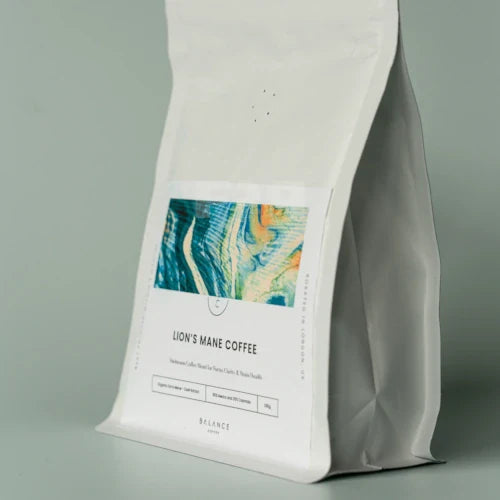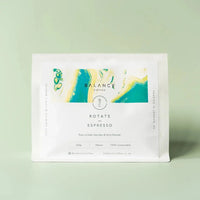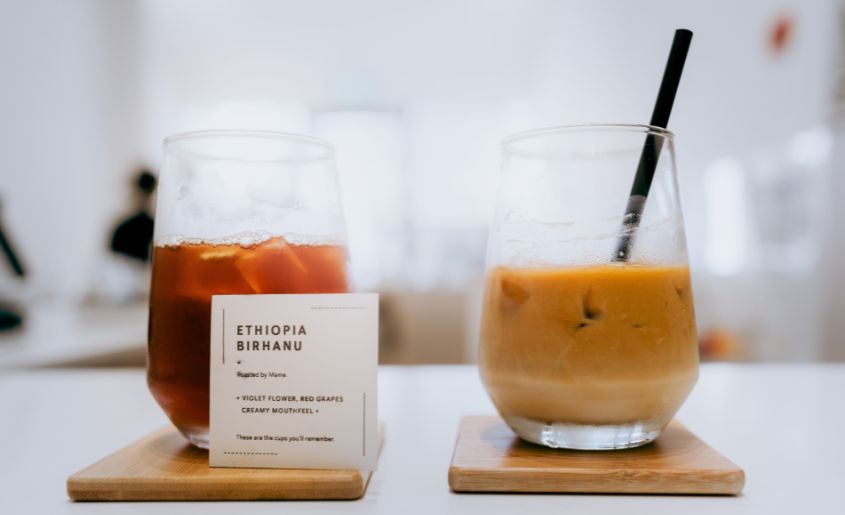Single origin coffee vs blend which should I buy and what's the difference?
I had my first experience with single origin coffee while working at Sanremo (one of the best espresso machine brands, in case you didn’t know) years ago.
Sipping my first cup of single-origin coffee was a beautiful shock to my senses.
Something was different when I wrapped my lips around that coffee mug.

I was lucky to spend over ten years sampling and taste-testing hundreds of rare single origins and blends to explore their unique characteristics. I still, to this day, continue to test various coffee for my brand, Balance Coffee.
Heck, when I wrote this blog post best coffee for pour over, I did my taste-testing once again too. Besides that's one very interesting post you should read.
Now, I can use my decade of hands-on experience to finally settle the debate on single origin vs blend - which one should you get?
So, stay with me as I demystify single origin coffee and blends for you so you can make the right choice.
Comparison Of Single Origin vs Blend Coffee
Do you know that according to a survey, 81% of coffee drinkers aged between 25 and 49 are willing to pay a 10% higher price for single-origin coffee?
While some coffee drinkers might tell you that single-origin coffee is the relatively new kid on the block, it is taking the industry by storm.
And you can join the storm by picking from our single origin coffee beans collection to start enjoying better flavours.
But that doesn’t necessarily mean that single-origin coffee is better. In fact, the debate on single origin vs blend just keeps getting more intense!
But to help you navigate these coffee types, let's examine some key differences between them.
| What We Compared | Single Origin Coffee | Blends |
|---|---|---|
| Flavour Profile | Sweet, Fruity and Delicate | Rich, Smooth and Balanced |
| Aroma | More noticeable and pronounced | Mellow, well-rounded and gentler |
| Acidity | More acidic | Less acidic |
| Bitterness | Less bitterness, more natural sweetness | More robust and earthy and punchy |
| Flavour Descriptors (examples) | Fruit like Berry and Citrus notes | Caramel and Chocolate notes |
There are no strict rules about which is better. But understanding the pros and cons can help you in your coffee journey.
The Pros and Cons of Single-Origin Coffee
Single-origin coffee has captured the spotlight because it brings a coffee menu to life by offering ever-changing experiences.
Instead of choosing the same blends all year round, you can opt for various seasonally offered single origins that taste wildly different.
But before you jump ship and get on the single-origin coffee train, you’ll need to understand its pros and cons.
| Pros | Cons |
|---|---|
| Location, weather conditions, farm, soil and altitude ranges all impact the final flavour of a specific coffee meaning it’s inherently unique. | Limited to certain periods of the year meaning single-origin coffee can only be produced in small batches and supply. |
| Displays unique flavour characteristics that can only be found in that distinctive, single-origin coffee meaning you’ll enjoy pronounced flavour notes. | Can be a little too acidic or intense for many coffee drinkers. |
| Work great with Hario V60, Chemex, Aeropress, and filter brew methods. | Doesn’t always work well with milk-based beverages like lattes. |
| For people that love fruity coffees | More scarce and rare. |
Pros and Cons of Coffee Blends
Coffee blends, much like single-origin coffee, have a separate fanbase.
If you are a fan, I suggest you check out our coffee blends collection to start making better quality brews daily.
They come with their own pros and cons, summarised below:
| Pros | Cons |
|---|---|
| Offers a smooth and well-balanced taste and pairs particularly well with milk-based drinks like flat whites and lattes. | Loses the distinct, unique coffee flavours of its origin during blending |
| A mix of two coffees produces a harmonious blend of the best qualities of coffee from different origins. | Are usually medium-roasted to darker to achieve a uniform taste (this can be a turn-off for coffee drinkers who prefer a purer single-origin coffee. |
| Can work great with or without milk but generally have less clarity of flavour. | More widely available |
Price comparison and Availability of Single Origin Coffee vs Blend coffee
Obviously, as a regular coffee drinker, you’d like to lean towards coffee that gives you more value for money and is accessible.
So let’s look at how both of them compare on these fronts.
| Factor | Single Origin Coffee | Blend Coffee |
|---|---|---|
| Price | Generally more expensive | Generally cheaper |
| Availability | Lower availability | Higher availability |
With that said, you should take both of these factors with a pinch of salt. This is because some premium coffee blends can cost you more than mediocre, single-origin coffee.
On the other hand, some single origin coffee is generally more available and accessible than specific blends. I recommend always exploring and buying from a trusted coffee roaster.
Definition of Single Origin and Blend Coffee
Single Origin Coffee Definition - Coffee that comes from one specific place, such as a single farm, region, or country. It highlights the unique flavours and characteristics of that area.
It is great for different brew method and the Aeropress is just one of many. You can read my blog post on the best coffee for Aeropress if you are a huge Aeropress brew fan.
But to bring some clarity to the chaos, the following are the different types of single-origin:
- Single Country / Origin
- Single Region
- Single Farm or Cooperative
- Single Macro or Nano Lot

Coffee enthusiasts and professionals tend to gravitate more toward single-origin coffee because of the original characteristics that are associated within a given origin, region, farm and micro-lot. There are notable tasting notes which are represented by a given location.
An example would be a natural Ethiopian coffee which has notes of bergamot, jasmine, and blueberry.
It’s worth mentioning, that single-origin coffee isn't for everybody.
On the other hand, coffee blend is a mixture of coffee beans from different places, combined to create a balanced flavour profile. Blends are designed to offer a consistent taste by combining the best qualities of various beans.
Typically, blend coffee are made for consistent and differentiated flavour profiles that pair best with milk-based drinks.
Navigating coffee's different flavours and aromas in a blend can often be quite confusing. But luckily, the Speciality Coffee Association invented the coffee flavour wheel to give you a common language for the aromas, tastes and flavours of coffee.
It makes distinguishing between different coffee types easier and also helps me craft healthy coffee blends at Balance Coffee.
Here’s what a coffee wheel looks like:

Source: sca.coffee
The Differences Between Single Origin and Blended Coffee
I’ve already provided a quick comparison between the two types for you. But let me break down the key differences between the coffee beans of single origin and blend for you.
The Characteristics of Single-Origin Coffee
Like I said before, single-origin coffee has a distinctly different flavour profile and characteristics.
Unique Flavour Profile of Single-Origin Coffee,
The flavour profile of a single-origin coffee is typically quite specific and nuanced at the same time. Since it comes from a single location, it offers inherent flavours produced by a given region and climate, producing a unique and complex flavour profile, especially when compared to blended coffee.
How the Region, Climate, and Growing Conditions Affect the Taste
Fun fact: Two single-origin coffees will taste very different. This is because the soil, water, and climate conditions differ, impacting the flavour profile of single-origin coffee.
Single-origin coffee can have tasting notes of blueberry, chocolate, cinnamon, and earthy flavours or floral tones, depending on their origin.
In fact, you can see how the different growing regions impact the flavour profile of single-origin coffee below:

Source: jayarrcoffee.com
Additionally, unfavourable growing conditions like low quality, or poorly maintained plants can make single-origin coffee unpalatable. This is why it’s important to buy your coffee from a quality roaster with great reviews.
Benefits of Drinking Single-Origin Coffee
Don’t listen to the naysayers! There are many benefits of opting for single-origin coffee that make the scales tilt in its favour during the blend vs single origin coffee debate.
So what are they?
- Knowing the exact source of your coffee lets you appreciate its unique characteristics much better
- Has a uniqueness of flavour that blends can’t rival
- Free of chemicals like pesticides, mycotoxins and mould that can be harmful to health
- It is nutrient dense owing to a slower maturation process
- Since single-origin coffee is not mass-produced and not readily available, you can enjoy its exclusivity.
- Inquisitive coffee drinkers can easily trace the entire bean-to-cup journey and understand the impact of growing conditions on the flavour profile
- The traceability and transparency of single-origin coffee bolsters sustainability and ethical sourcing, which has historically been a problem in the industry
The Characteristics of Coffee Blends
And now for single-origin coffee’s arch-rival, coffee blends! So what are its unique characteristics that make it stand out in the fight between blended coffee and single origin?
Flavour Profile of Coffee Blends
The flavour profile of blended coffee is made by combining different coffee beans that complement each other. This makes the overall blend balanced, mellow and more muted when compared to single-origin.
You can find all kinds of tasting notes and flavours in blends. Blending coffee is similar to alchemy, and the coffee wheel discussed earlier can be super helpful during the process of deciding what coffees to merge together.
How Different Types of Beans are Blended to Create a Specific Taste
The most obvious way to create a good blend is by mixing two high-quality coffee beans. But with wide bean varieties to choose from, finding the two you like can take some time and experimentation.
There are no strict rules for creating blends from beans. It is often a personal and creative experience for roasters. But in my experience, knowing your preferred taste is essential in coffee blending.

Yes, that’s right! Often, a roaster picks a particular flavour and taste that they want to achieve and then work backwards. They do the maths to determine which bean varieties will help them achieve their target price and flavour price.
Usually, it is recommended to start with chocolate notes as the base of your blend. Peruvian, Brazilian and Mexican single-origin beans are a great way to do this.
Then, the coffee roaster mixes the chosen beans in a set ratio (often based on experience and expertise).
The types of coffee roasts also play an essential role in blending coffee. The roast profiles of beans used in the blend influence the body of the coffee.
I recently wrote a blog post on some of the best roast brands; as such, I believe the best medium roast coffee beans would leave you wanting.
Benefits of Drinking Blend Coffee
Drinking blends have the following benefits for coffee lovers:
- Blends give you a more consistent coffee each time, They allow you to make the most out of more affordable coffee beans while still enjoying your favourite flavours and roasts
- Costs lesser than single-origin coffee because two or more components are mixed at varying percentages.
- Blends tend to have a slightly longer shelf life.
That said, coffee blends are ideal for drinkers who want to remain married to their favourite blend or flavour! Why? Because they can be drunk all year round whereas single-origin coffee is only available seasonally.
5 Best Single Origin Coffee Beans Products In The UK
How do you take your coffee? Hot with a splash of cream or maybe cold-brewed? No matter what option you choose, your cup of joe won’t delight you if you don’t choose the right coffee beans.
Since I have taste-tested and tried many single-origin coffee beans in the UK, let me give you my top five picks.
In addition to the taste and flavour profiles of single-origin coffee beans, I have also analysed:
- Whether or not they are optimised for health (free of the nasties that can harm your health)
- How fresh they are (the fresher, the better, obviously!)
- Their quality and grade (premium quality and speciality-grade are preferred)
- Whether they are Arabica or Robusta (Arabica coffee is more superior in quality)
- Emphasis on sustainability, fair trade and ethical sourcing practises
- Uniqueness of the flavour
- Customer Reviews
Choosing coffee distilled through my grading criteria is going to save you time, effort, money and well, the pain of bad-tasting coffee!
1. Single Origin Taster Pack by Balance Coffee
While it may seem like I picked this one right off the bat, I do so with good reason! You know how everything you put in your body either fuels or fights disease?
Our single-origin taster pack gives you powerful health benefits and wards off disease. Our taster pack offers 100% Arabica and speciality coffee that is carefully optimised for health.

You can expect light to medium roasts and unique flavour profiles in this pack. The coffee is seasonally sourced, so you can expect only the freshest beans each time you order.
All the coffee at Balance, including the Single Origin Taster Pack, is bursting with over 1000+ antioxidants. This means every mug you brew with this will give you a healthy boost while you get your daily jolt of caffeine in.
But you certainly don’t have to just lean on my word! Look at what customers who have tried our taster pack have to say about it.

Visit Balance Coffee shop to get our Single OriginTaster Pack delivered to your doorstep fast.
2. Coffee Masters Peruvian Coffee Beans
The second one on the list of the best single-origin coffee beans in the UK is Coffee Masters’s Peruvian Coffee Beans.
Not only are these beans single-origin entirely, but they are also roasted in the UK to supply fresh beans to customers.

This 100% Arabica coffee bean pack is sourced from Jaen and San Ignacio in Northern Peru. They are also one of the best single-origin coffee beans for espressos!
What’s more? This pack of beans is an accolade winner and was crowned the Great Taste Award Winner in 2018. And the best part is that this product certainly lives up to its name!
When brewed to perfection, a cup of joe from this pack will give you subtle yet sweet-tasting notes with a smooth finish. It also has a splash of tang, zest and a medium body.
Lastly, this coffee is fair trade and organic, putting it on the must-have list.
Check out coffee specifications
3. Rounton Coffee Roasters El Salvador Bosque Lya
Rounton Coffee Roasters sells a range of single-origin coffee on Amazon and its own website and most of them have fantastic reviews.
However, this specific single-origin coffee comes from the foothills of El Salvador's Santa Ana volcano. This Bourbon varietal is farmed on the 96-hectare estate by farmer Joe Melina.

The medium roast lends itself nicely to both espresso and filter brews. Moreover, the flavour notes of plum, milk chocolate, and hazelnut shine through in cappuccinos and lattes once the grind and dosage are just right.
It doesn’t have the complexity or unusual flavour found in more expensive single-origin coffees, but if you want a rich, mellow traditional coffee that's a major step up from most supermarket selections, you can't go wrong for the price.
In fact, it gives you pretty good value for money and is priced at £22.50 for a 1 kg pack.
Check out product specifications
4. Coffee Bean Shop Monsoon Malabar
Sourced straight from the heartlands of India, Coffee Bean Shop’s Monsoon Malabar is a unique but incredible find.
So what makes it so special? This single-origin coffee is so premium because it is dried and aged slowly in the monsoon winds of India.

The coffee is stacked in open-sided barns, and the monsoon winds from the Arabian sea swell up the beans from June to September.
It is the brand’s second most popular coffee. It can be brewed using different methods, but like other single-origin coffee beans, it is best brewed as an espresso because it offers an excellent crema.
These coffee beans have earthy, spicy, and tobacco-like tasting notes, making them rich, delicious, and unique.
It also has a medium body and strength level and is meticulously roasted in small batches.
Check out coffee specifications
5. Assembly House Single-Origin Espresso Brazil
In the battle between single-origin coffee and blend espresso, Assembly House’s single-origin pack lends points to the former.
These Red Bourbon beans are sourced from Monte Santo de Minas, southeastern Brazil, and then honey-processed for an exotic taste.

It gives some surprising tasting notes, like dried fruits and almond butter, with a creamy aftertaste.
These coffee beans, when brewed to perfection, offer a cup of coffee that is super sweet, rich, and full of layered dried fruits. Sounds mouthwatering, no?
Since Assembly House’s single-origin coffee is rotated as per seasonality, these premium coffees are available at competitive prices.
These beans are excellent for rich espressos but shine bright in other coffee forms. The beans are also roasted in small batches so that you can enjoy fresh coffee each time.
Check out coffee specifications
The 5 Best Coffee Blend Products In The UK
There is a staggering number of coffee blends available, but that doesn’t mean you have to feed your coffee machine any blend you can get your hands on.
Using cheap or poor-quality coffee blends can ruin your morning coffee cup. So just like my top five picks for single-origin coffee, I also deployed my coffee battle-tested grading criteria for blends.
You know the drill already, but here’s a quick recap - I analysed the coffee grade (commercial vs speciality), optimisation for health, flavours, customer reviews and sustainability efforts.
So without further ado, let’s get into it.
1. Stability Blend by Balance Coffee
Who doesn’t want mouth-watering coffee every morning? Luckily, our stability blend makes it possible for you to enjoy healthy and delicious coffee daily.
Like all other blends in our store, our stability blend is made from 100% premium Arabica and is speciality-grade. It is perfect for coffee beginners and drinkers who enjoy chocolate-tasting notes.

It’s our top seller for a reason. The delicious tasting notes of milk chocolate, hazelnut and fig come together beautifully for a flavour-packed punch.
And let’s not forget what makes our coffee truly different - focus on health! It is tested and screened for nasties like mould, mycotoxins and pesticides. This ensures premium quality and also boosts the sustainability of the industry.
Moreover, it is rich in vitamin B3, and polyphenols and has 1000+ antioxidants. Our coffee is sourced from the top 5% of the global suppliers, and we pay a 25% higher price for it.
Seriously, your morning cup of joe doesn’t get any better than this.
Let’s see if our customers feel the same about our Stability Blend:

Check out coffee specifications
2. Bird and Wild Espresso Blend
Who doesn’t love a steaming espresso mug to deliver a daily jolt of caffeine? This blend is perfect for you if you are anything like me and love an espresso with a good crema.
Bird and Wild Espresso blend offers some great coffee and lets you do some good in the world while drinking it.

The brand goes to all lengths to source organic and 100% fair-trade coffee beans.
Every bag of beans you buy supports the RSPB (Royal Society for the Protection of Birds) and the Smithsonian Migratory Bird Center.
Their Espresso Blend is delicious and has lovely balanced notes of cocoa, making it one of the best coffee beans for espresso. To top it off, it has a smooth and silky finish which makes the coffee-drinking experience spectacular.
It is 100% Arabica, so there is your stamp of quality on this blend! Bird and Wild pack them in 200g bags to lock the freshness right in.
It is also a hit with the customers.
Check out coffee specifications
3. Spiller and Tait Signature Blend Coffee Beans
Don’t your ears perk up every time you hear the phrase ‘signature blend’ from a famous coffee brand?
Well, mine sure do. But I am glad to report that Spiller and Tait’s Signature Blend certainly lives up to its name.

Spiller and Tait sources premium Arabica beans from areas known for quality coffee production, like India, Ethiopia, Brazil and Columbia.
Their Signature Blend is robust and offers a rich flavour profile with lots of depth, I must say. It is a medium to high roast, so you can use it for a strong caffeine kick in the morning.
But it's also pretty versatile, so feel free to use it on chilly evenings as a creamy latte. These beans are universal in the sense that you can use them for all types of brewing methods.
Check out coffee specifications
4. Pelican Rouge Concerto Coffee Blend
My top picks for coffee blends in the UK, wouldn’t be complete without a blend that offers excellent value, right?
So here comes the Pelican Rouge Concerto Coffee Blend. It is a medium organic roast that provides lots of flavour and value for money!

Both the spice and the bitterness of the coffee are delivered with a delicacy. You’ll also enjoy the mellow undertones of its flavour that comes with silky smoothness.
The company has been in the coffee space for quite a while now and is also into ethical sourcing. Around 50% of the coffee that they sell is sourced ethically.
The beans are sourced from approximately 20 countries and have their own roaster in Holland.
The best part is that the brand focuses on fostering the sustainability of the coffee industry. It regularly invests in programs like educational campaigns in Guatemala.
The coffee tastes better when you know the brand has a conscience.
5. Lavazza Qualita Rossa – Arabica and Robusta Medium Roast
For the last one on our list, I have the Lavazza Qualita Rossa. Now, it is hard to find one that gives you both good value and good taste when it comes to coffee.
But luckily, this coffee blend does give us both in a single pack. As the name suggests, this blend combines Arabica and Robusta coffee beans.

Lavazza is also quite a renowned name in the coffee world and has been around for as long as I can remember.
The coffee has a Moorish taste with notes of dried fruits and milky chocolate. The beans are sourced from Arabica and Brazil and are ideal for filter coffee machines.
The taste is enjoyable, and the aroma is quite pleasant too. You can easily brew some delicious espresso coffee, but luckily, it is also great for coffee with a splash of the white stuff (looking at you creamy lattes!).
It’s a blend that is hard to miss.
Check out coffee specifications
Frequently Asked Questions (FAQs):
Is single-origin coffee better than blends?
The choice between the two actually depends on your personal preference. A single-origin coffee has the most unique and unaltered flavour profile, whereas coffee blends include characteristics from other beans. Single-origin coffees are bolder and more powerful, whereas a coffee blend is balanced.
What are single-origin and blend coffee?
Single-origin coffee is sourced from one location, whereas a blend includes beans from many places. Single-origin coffees are typically more potent, with a more robust and unusual flavour. Coffee blends are more consistent in taste and better balanced since the different beans complement one another.
What is the advantage of single-origin coffee vs blend?
Single-origin coffees have a more distinguished and pronounced flavour profile, bolder and more powerful, whereas a coffee blend balances out two flavour profiles by using two or more beans that complement one another. Single-origin coffee is also often more nutrient dense as chemicals like fertilisers are not used during production and processing.
Why might you prefer to use single-origin beans instead of a blend?
One of the numerous benefits of single-origin coffee is the opportunity to sample a more pure flavour. You may also prefer single origin coffee if you're brewing using a filter method like Hario v60 or Chemex because they allow more subtle flavours to be expressed.
Why are blends cheaper than single-origin?
Single origin coffee is more expensive because it comes from one single coffee farm or lot and is produced in smaller quantities than blends. Therefore, they are more rare and harder to farm compared to the type of coffees used within coffee blends.
In order words, it's the choice of what coffees are used for those specific purposes. Blends usually have brazil, mexico, colombia because they are more affordable than say an ethiopia.
Conclusion
Single-origin coffee, with its unique and exotic flavours, are hard to rival.
Coffee enthusiasts all over the world love the richness and uniqueness of flavours that they offer.
The fact that single-origin coffee is traceable, healthier and more premium is like the perfect cherry on top.
That said, the debate on ‘single origin coffee vs blend - which is better’ is far from over.
While single-origin coffee holds its head high in the coffee world, there is no denying that blends are fantastic too.
Lastly, you should experiment to find the coffee that best resonates with you. Step out of your comfort zone, try new bean varieties, and then settle on the best one.
For single origin, I recommend you try the Esmerelda Brazil coffee and for blend, the Stability Blend coffee.














